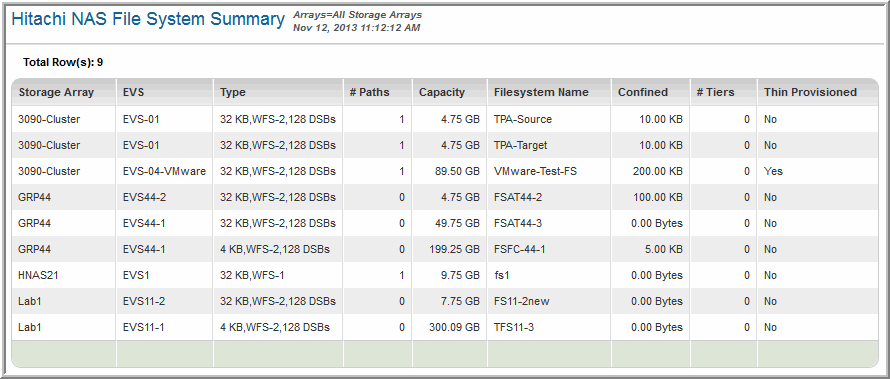

Storage Array | The name given to the storage array. |
EVS | Name given to the enterprise virtual server (EVS). |
Type | Provides filesystem characteristics, such as ro (read-only), syslocked (system locked), or WORM. Possible values: Block Size.4KB or 32KB.ro = filesystem has been mounted read-only.syslocked = filesystem has been syslocked.WORM / non-strict WORM = filesystem is WORM or non-strict WORM.File system types = WFS-1 or WFS-2.DSB count = for WFS-2 filesystems, the DSB count is shown.replication target = filesystem is being used as the target for high-speed replication.NDMP recovery target = filesystem is mounted to recover a filesystem image from tape.read resiliency = filesystem is mounted to tolerate disk errors for read-only operations.write resiliency = filesystem is mounted to tolerate disk errors for read and write operations. |
# Paths | Number of paths associated with the filesystem. |
Capacity | Total capacity of the filesystem. Values are stored in the database as KiB and rendered according to your user profile preferences. |
Available | The amount of formatted, available capacity. |
Used | Used capacity of the filesystem. The amount (and percentage) of formatted capacity used by live and snapshot data. If files are queued for deletion, the total size of files awaiting deletion will be shown. If a filesystem is not mounted, the current state of the filesystem will be shown. If the current state shows “Not determined,” the filesystem software has not accessed the underlying storage to determine the state and usage. This can occur when storage is inaccessible or the filesystem has failed a numerous is considered to be too unstable to access. Values are stored as KiB in the database and rendered according to your user profile preferences. |
Utilization | Percentage of the filesystem that is used. |
Filesystem Name | The instance name of the filesystem. For storage-based snapshots, this is the name assigned when the filesystem was created or renamed. |
Confined | The capacity to which the filesystem has been confined. An “-” indicates that the filesystem is not confined. |
# Tiers | Number of tiers associated with the filesystem. |
Thin Provisioned | Indicates if the filesystem is thinly provisioned. |